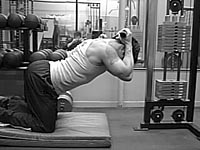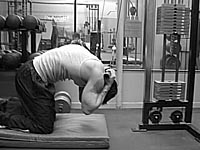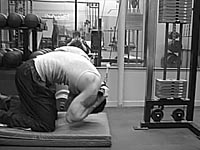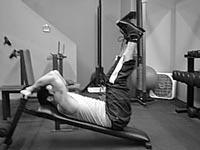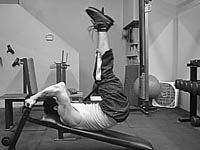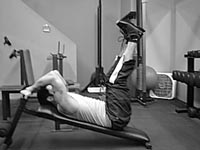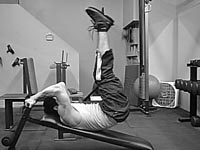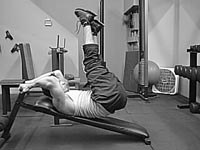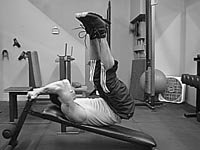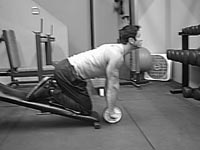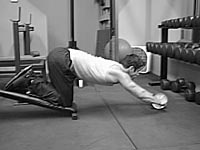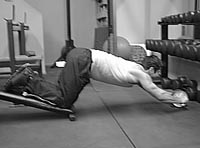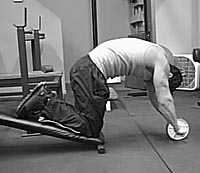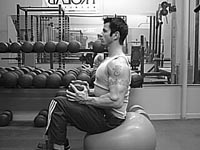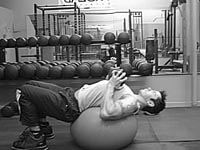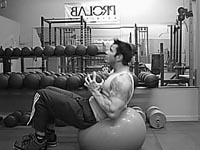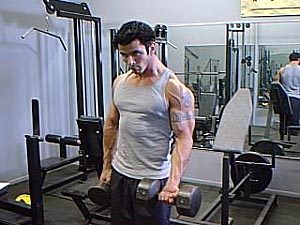|
Teaching An
Old Dog New Tricks - Part Deux
Back with the Six-Pack Attack I think it was best stated by two of the world's most well known strength coaches, Hans and Franz, "don't undo your belt, you might cause a flab-a-lanche". Whether you're an athlete, a bodybuilder, or Joe Weekend Warrior, nobody wants to cause a flab-a-lanche when summertime is just around the corner. It's really rather embarrassing. So unless you're training for your next Sumo competition or planning an excavation in the snowy trenches of Antarctica, I'd say you don't have much time to waste my friend. On that note, let's get down to business. The abdominals and their peripheral muscles are some of the easiest muscles to develop when trained properly, properly being the operative word there. They don't require hours of tedious work, or hundreds of reps on the Ab Roller, as the exercise evangelists on the info-mercials would have you believe. In fact, training abs really shouldn't be very time consuming at all. So if these muscles are so easy to develop, then why is an impressive set of abs so few and far between? In short, bad planning. Diet is obviously a huge variable in creating the desired hormonal environment for fat loss to occur, but that is beyond the scope of this article. What we will focus on, however, is designing a training protocol that really works for getting a granite midsection in a hurry. Abs, not unlike other muscles, require different training strategies to achieve different desired effects. High reps may not be all bad if you're an athlete who is after increased function and core stability, but for most people trying to develop these muscles for aesthetic purposes, high reps will usually earn you little to no progress. Would you train your chest with sets of 50-100 reps if you were trying to achieve maximal size and strength? Of course not. Abs are no different. When you consider that most people have a predominantly fast twitch abdominal muscle fiber makeup, it only makes sense to train them using high intensity, lower rep brackets and heavier loads. Based on the hundreds of clients I've worked with over the years, I've concluded that most people's ideal rep range to achieve abdominal hypertrophy (muscle growth) is somewhere between six and twelve. Please take notice that I did not say between 50 and 100. We'll leave that to the folks on the Super-duper-mega-abdominizer commercials that seem to have a monopoly on late-night television lately. Training in this range (6-12 reps) with the proper movements is about the closest thing to a surefire method I've seen for ab development. There are literally dozens of different ab movements that seem to accomplish basically the same end result to some degree. There are also ab movements that I wouldn't waste a single rep on because they are, simply put, biomechanically worthless. These seem to be the movements that many people in the gym end up focusing on anyway (go figure). On that note, here are a handful of my favorite ab movements that I guarantee, if done properly, will deliver the goods in a hurry. Movement One- Cable Crunches
Movement Two - Reverse Incline Crunches
Movement Three - Reverse Incline Twist Crunches
Movement Four- Decline Jackknife push-ups This is a slight twist on the Jackknife push-ups popularized by "The Evil Russian", strength guru Pavel Tsatsouline. The primary differences here are simply the incline and the breathing technique. Neither method is wrong, they just serve different purposes. Pavel teaches not to exhale during the contraction because his primary focus is function and stability. This is a great technique if you plan on getting bashed in the abs with a Crowbar (many of his clientele are military and S.W.A.T. team members). For the rest of us however, I believe exhaling on the contraction minimizes intra-abdominal pressure, thereby lending itself to greater fiber recruitment, thus greater hypertrophy. On that note... This exercise will require one of those nifty little wheels reminiscent of a Bruce Jenner training tool from the 70's Olympic Games. Don't laugh. This device from the old school is all business when used properly.
Movement Five- Weighted Swiss Ball Crunches This can be one of the best or worst abdominal movements you will ever do. Make no mistake. There are certain intricacies in this movement that really do make all the difference.
TIP Beginners may choose to keep a wider base between the feet to help stability while getting used to this movement. Intermediate and advanced trainees will want to keep the most narrow base possible, as the increased instability will likely generate greater muscle fiber recruitment. Putting it All Together So what do I recommend for an actual workout? Most people are shocked at how little time I actually have my clients spending on their abs in the gym. The abs are definitely a clear case for quality over quantity. This especially applies to beginners. Some more advanced trainees may require a slightly higher volume, but still not nearly as many sets as some people might have you believe. I hate to make blanket statements and/or generic recommendations, as there are occasional exceptions to nearly every rule, but generally my volume/frequency recommendation would be as follows: Beginners 2-3 sets, twice a week Intermediate 3-4 sets, three times a week Advanced 5-6 sets, three to four times a week. As most other body parts, if your abs are lagging or simply a priority for whatever reason (like your friends keep trying to push you back in the water, and screaming something about an endangered species list every time you lay out at the beach), do not hesitate to train them first in your workout, when your neuromuscular efficacy is at its peak. Your ab workout will not likely impact your bench work negatively, but a hard chest day may very well diminish your potential resources for hitting abs at 100%. Follow these simple guidelines combined with a good fat-loss diet and you will be washing laundry on your midsection in no time!
|
